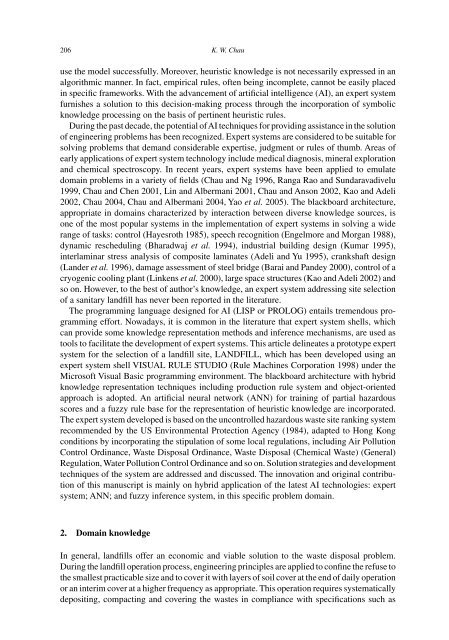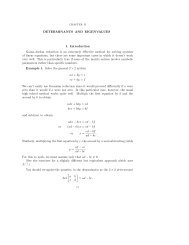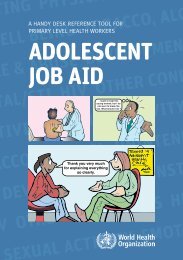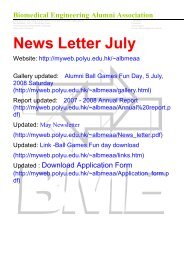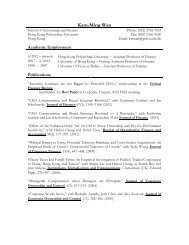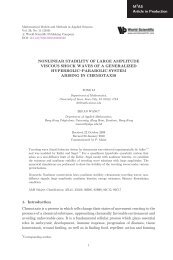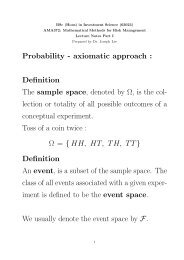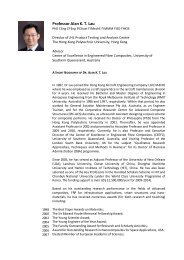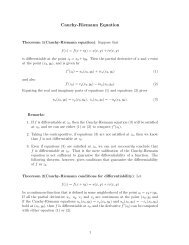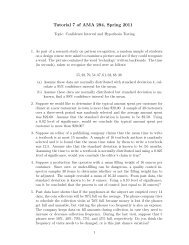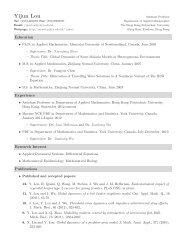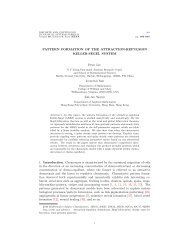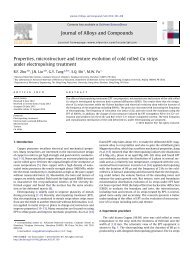Prototype expert system for site selection of a sanitary landfill
Prototype expert system for site selection of a sanitary landfill
Prototype expert system for site selection of a sanitary landfill
Create successful ePaper yourself
Turn your PDF publications into a flip-book with our unique Google optimized e-Paper software.
206 K. W. Chauuse the model successfully. Moreover, heuristic knowledge is not necessarily expressed in analgorithmic manner. In fact, empirical rules, <strong>of</strong>ten being incomplete, cannot be easily placedin specific frameworks. With the advancement <strong>of</strong> artificial intelligence (AI), an <strong>expert</strong> <strong>system</strong>furnishes a solution to this decision-making process through the incorporation <strong>of</strong> symbolicknowledge processing on the basis <strong>of</strong> pertinent heuristic rules.During the past decade, the potential <strong>of</strong>AI techniques <strong>for</strong> providing assistance in the solution<strong>of</strong> engineering problems has been recognized. Expert <strong>system</strong>s are considered to be suitable <strong>for</strong>solving problems that demand considerable <strong>expert</strong>ise, judgment or rules <strong>of</strong> thumb. Areas <strong>of</strong>early applications <strong>of</strong> <strong>expert</strong> <strong>system</strong> technology include medical diagnosis, mineral explorationand chemical spectroscopy. In recent years, <strong>expert</strong> <strong>system</strong>s have been applied to emulatedomain problems in a variety <strong>of</strong> fields (Chau and Ng 1996, Ranga Rao and Sundaravadivelu1999, Chau and Chen 2001, Lin and Albermani 2001, Chau and Anson 2002, Kao and Adeli2002, Chau 2004, Chau and Albermani 2004, Yao et al. 2005). The blackboard architecture,appropriate in domains characterized by interaction between diverse knowledge sources, isone <strong>of</strong> the most popular <strong>system</strong>s in the implementation <strong>of</strong> <strong>expert</strong> <strong>system</strong>s in solving a widerange <strong>of</strong> tasks: control (Hayesroth 1985), speech recognition (Engelmore and Morgan 1988),dynamic rescheduling (Bharadwaj et al. 1994), industrial building design (Kumar 1995),interlaminar stress analysis <strong>of</strong> compo<strong>site</strong> laminates (Adeli and Yu 1995), crankshaft design(Lander et al. 1996), damage assessment <strong>of</strong> steel bridge (Barai and Pandey 2000), control <strong>of</strong> acryogenic cooling plant (Linkens et al. 2000), large space structures (Kao and Adeli 2002) andso on. However, to the best <strong>of</strong> author’s knowledge, an <strong>expert</strong> <strong>system</strong> addressing <strong>site</strong> <strong>selection</strong><strong>of</strong> a <strong>sanitary</strong> <strong>landfill</strong> has never been reported in the literature.The programming language designed <strong>for</strong> AI (LISP or PROLOG) entails tremendous programmingef<strong>for</strong>t. Nowadays, it is common in the literature that <strong>expert</strong> <strong>system</strong> shells, whichcan provide some knowledge representation methods and inference mechanisms, are used astools to facilitate the development <strong>of</strong> <strong>expert</strong> <strong>system</strong>s. This article delineates a prototype <strong>expert</strong><strong>system</strong> <strong>for</strong> the <strong>selection</strong> <strong>of</strong> a <strong>landfill</strong> <strong>site</strong>, LANDFILL, which has been developed using an<strong>expert</strong> <strong>system</strong> shell VISUAL RULE STUDIO (Rule Machines Corporation 1998) under theMicros<strong>of</strong>t Visual Basic programming environment. The blackboard architecture with hybridknowledge representation techniques including production rule <strong>system</strong> and object-orientedapproach is adopted. An artificial neural network (ANN) <strong>for</strong> training <strong>of</strong> partial hazardousscores and a fuzzy rule base <strong>for</strong> the representation <strong>of</strong> heuristic knowledge are incorporated.The <strong>expert</strong> <strong>system</strong> developed is based on the uncontrolled hazardous waste <strong>site</strong> ranking <strong>system</strong>recommended by the US Environmental Protection Agency (1984), adapted to Hong Kongconditions by incorporating the stipulation <strong>of</strong> some local regulations, including Air PollutionControl Ordinance, Waste Disposal Ordinance, Waste Disposal (Chemical Waste) (General)Regulation, Water Pollution Control Ordinance and so on. Solution strategies and developmenttechniques <strong>of</strong> the <strong>system</strong> are addressed and discussed. The innovation and original contribution<strong>of</strong> this manuscript is mainly on hybrid application <strong>of</strong> the latest AI technologies: <strong>expert</strong><strong>system</strong>; ANN; and fuzzy inference <strong>system</strong>, in this specific problem domain.2. Domain knowledgeIn general, <strong>landfill</strong>s <strong>of</strong>fer an economic and viable solution to the waste disposal problem.During the <strong>landfill</strong> operation process, engineering principles are applied to confine the refuse tothe smallest practicable size and to cover it with layers <strong>of</strong> soil cover at the end <strong>of</strong> daily operationor an interim cover at a higher frequency as appropriate. This operation requires <strong>system</strong>aticallydepositing, compacting and covering the wastes in compliance with specifications such as


